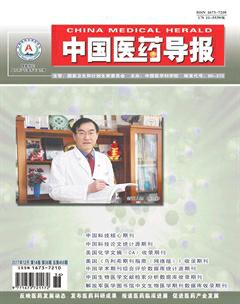157例支气管哮喘儿童生命早期相关因素分析
王树霞+陈伟斌
[摘要] 目的 探討儿童支气管哮喘生命早期相关因素,为临床预防和治疗提供参考。 方法 选择2015年8月~2016年8月在上海中医药大学附属岳阳中西医结合医院儿科门诊诊断的0~14岁哮喘患儿157例,以及与相关病例同时就诊的年龄、性别、民族、居住地相同的没有心身相关疾病或反应的非呼吸道疾病儿童224例成组匹配。对157例哮喘患儿和224例非哮喘儿童进行病例对照研究,利用χ2检验,二分类Logistic回归分析儿童支气管哮喘生命早期危险因素。 结果 单因素分析结果示:早孕反应,妊娠高血压,母孕期情绪稳定,孕期吸烟或被动吸烟,剖宫产,早产,母乳喂养,母乳期间食用蛋、大豆、鱼和贝壳类、花生和坚果类等,1岁以内使用抗生素,饲养宠物,反复呼吸道感染11个因素与哮喘有关;Logistic回归分析结果示:孕期吸烟或被动吸烟,剖宫产,早产,母孕期间食用蛋、大豆、鱼和贝壳类、花生和坚果类等,1岁以内使用抗生素,反复呼吸道感染6个因素为危险因素;母乳喂养、母孕期情绪稳定以及饲养宠物为保护因素。 结论 让孕妇和患儿远离各种危险因素,加强保护因素,降低儿童哮喘的发病率。
[关键词] 儿童支气管哮喘;相关因素;儿童生命早期;Logistic回归分析
[中图分类号] R725.6 [文献标识码] A [文章编号] 1673-7210(2017)12(c)-0089-04
[Abstract] Objective To provide reference for clinical prevention and treatment of child bronchial asthma by discussing its related factors in early stage of life. Methods 157 cases of children with asthma and 224 cases of children with non-respiratory illnesses were selected into groups for control study. They were all 0 to 14 years old and diagnosed by pediatric clinic of Yueyang Hospital of Integrated Chinese and Western Medicine, Shanghai University of Traditional Chinese Medicine during August 2015 to August 2016. Children in the same group had related illness, same age, sex, nationality, place of residence of psychosomatic related diseases or reaction case-control studies were conducted between 157 cases of children with asthma and 224 cases of normal children, in which χ2 test and Logistic regression model analysis methods were adopted to analyze the risking elements in the early life stage of bronchial asthma children. Results The result of univariate analysis indicated that: 11 elements might be related with asthma, which includes morning sickness, hypertension of pregnancy, emotional stability, smoking or passive smoking during pregnancy, caesarean section, premature birth, breast feeding, eat egg, soy, fish and shellfish, peanuts, nuts during breast feeding, use of antibiotics within one year of age, keeping pets, recurrent respiratory tract infection. Logistic regression analysis results showed that: risking factors were smoking or passive smoking during pregnancy, caesarean section, premature birth, eat egg, soy, fish and shellfish, peanuts, nuts during breast feeding, use of antibiotics within one year of age and recurrent respiratory tract infection. Protective factors were breast feeding, Emotional stability and keeping pets. Conclusion Pregnant women and children a should be kept away from all kinds of risking factors and strengthen the protection factors.endprint
[Key words] Childhood asthma; Correlative factor; Children′s early life; Logistic regression model analysis
哮喘是变态反应性疾病的重要组成,也是全球范围内严重威胁儿童健康的一种主要慢性疾病,其发病率及死亡率呈上升趨势。儿童哮喘危险因素很多,包括本身因素(包括心理因素)、家庭、环境等。有研究提示哮喘的病因可能与生命早期,特别是胎儿期的环境因素暴露有密切关系,因此有学者提出“疾病起源于胎儿”的假说[1-2],因此在预防儿童哮喘和变应性疾病时应从生命早期(即胎儿至2岁以前)开始。在此前提下,本研究探讨哮喘患儿的相关危险因素,从而认识儿童哮喘的危险因素和保护因素以便于有效的预防。
1 对象与方法
1.1 研究对象
选择2015年8月~2016年8月在上海中医药大学附属岳阳中西医结合医院儿科门诊诊断的0~14岁哮喘患儿157例,以及与相关病例同时就诊的年龄、性别、民族、居住地相同的没有心身相关疾病或反应的非呼吸道疾病成组匹配儿童224例。儿童哮喘诊断标准符合《儿童支气管哮喘诊断与防治指南》[3]。
1.2 研究方法
设计统一的调查表,包括共15个相关因素,登记如下:早孕反应,妊娠高血压,母孕期情绪稳定,孕期吸烟或被动吸烟,剖宫产,早产,母乳喂养,母孕期间避免食用蛋、大豆、鱼和贝壳类、花生和坚果类等,1岁以内使用抗生素,饲养宠物,及时补充维生素D和钙剂,经常户外活动,6个月以后添加蛋白质辅食,反复呼吸道感染,出生体重大于4 kg。
1.3 研究方法
问卷调查(课题组设计)每一问题都有明确的答案,不模棱两可。对调查员进行统一的培训,使其了解调查内容的含义,统一标准、方法和调查技巧。
1.4 统计学方法
采用SPSS 13.0统计学软件进行数据分析,计量资料用均数±标准差(x±s)表示,两组间比较采用t检验;计数资料用率表示,组间比较采用χ2检验;多因素分析采用Logistic回归分析,以P < 0.05为差异有统计学意义。
2 结果
2.1 一般资料
病例组157例,平均(11.57±2.05)岁,其中男99例(63.06%),女58例(36.94%)。对照组224例,平均(10.87±2.45)岁,其中男148例(66.07%),女76例(33.93%)。两组性别构成比和平均年龄差异无统计学意义(P > 0.05)。
2.2 单因素分析结果
单因素分析结果显示:早孕反应,妊娠高血压,母孕期情绪稳定,孕期吸烟或被动吸烟,剖宫产,早产,母乳喂养,母孕期间食用蛋、大豆、鱼和贝壳类、花生和坚果类等,1岁以内使用抗生素,饲养宠物,反复呼吸道感染11个因素与儿童哮喘相关,差异有统计学意义(P < 0.05)。见表1。
2.3 Logistic回归分析结果
Logistic回归分析结果:孕期吸烟或被动吸烟,剖宫产,早产,母孕期间食用蛋、大豆、鱼和贝壳类、花生和坚果类等,1岁以内使用抗生素,反复呼吸道感染6个因素为危险因素(OR > 4);母乳喂养,母孕期情绪稳定以及饲养宠物3个因素为保护因素(OR < 1)。见表2。
3 讨论
有研究指出,诸如出生缺陷、儿童孤独症、多动症、哮喘、糖尿病、不孕不育、肥胖、心脑血管疾病、代谢综合征等疾病的病因,可能与生命早期、特别是胎儿期的有密切关系,即存在发育起源[4-5]。基于“疾病起源于胎儿”的假说[1-2],研究环境、遗传和行为等因素的早期暴露对生命周期的影响,已成为目前世界研究主流之一。本研究通过研究哮喘患儿生命早期的危险因素,为临床预防和治疗提供参考。
本研究显示,母乳喂养和母孕期情绪稳定为保护因素。母乳喂养可以降低特应性反应及哮喘的危险性,研究表明奶粉喂养和混合喂养的宝宝喘息发作的概率要比母乳喂养高,母乳喂养的孩子表现出更强的肺容量且不易缺氧,调节呼吸能力较强[6-8]。
同时母亲怀孕时的心情好坏,会对孩子呼吸系统产生影响,产前心理压力是影响固有免疫和获得性免疫改变的一个独立危险因素,美国哥伦比亚儿童环境健康中心研究279名妇女,约70%的母亲承认,她们在怀孕期间曾高度焦虑或抑郁,结果她们的孩子在5岁前都患有哮喘[9]。
本研究显示饲养宠物是哮喘的保护因素,2013年的1项研究从妊娠期开始随访至生后1年,观察呼吸道症状的频度与狗、猫接触关系,其中30名接触宠物的婴儿中无一人发病,而99名未接触的宠物的儿童中有15名有过喘息性支气管炎[10];也有研究显示婴儿期较高的室内宠物或有害的过敏原可以降低患哮喘的风险[11],这两项研究结果可由1989年Strachan等[12]提出的“卫生假说”解释,现在卫生条件和环境的改善,已经应用疫苗和抗生素,家庭成员规模的缩减,减少了对微生物和细菌产物的早期暴露,从而增加了对环境过敏原的过敏反应。而生命早期接触宠物是在一定程度上是增加了对微生物的早期暴露。研究显示在那些敏感的哮喘患者中,暴露在高水平的狗和猫过敏原的情况下,哮喘发作明显增加。减少对过敏原的接触可能导致哮喘发作显著降低[13]。因此本研究饲养宠物是哮喘的保护因素这一结果仅针对于生命早期甚至是围生期,而对于已经明确诊断哮喘且有猫狗敏感的患者应当避免与相应过敏原接触。
孕期吸烟或被动吸烟,剖宫产,早产,母孕期间食用蛋、大豆、鱼和贝壳类、花生和坚果类等,1岁以内使用抗生素,反复呼吸道感染6个因素为危险因素。吸烟或被动吸烟的孕妇,烟中尼古丁可刺激下可发生迷走神经引起支气管痉挛;支气管黏膜上皮的增生和变异也是焦油引起。支气管黏膜上皮细胞及其纤毛被氰氢酸损害,使支气管黏膜分泌黏液增多,气道阻力增加,导致肺的净化功能和纤毛活动减弱,从而反射性地引起支气管痉挛。所以吸烟可直接间接地引起支气管痉挛,从而诱发哮喘发病。母亲在妊娠期吸烟或暴露于吸烟环境是导致儿童罹患哮喘的危险因素[14]。父母吸烟的孩子患哮喘的风险要大于父母不吸烟的孩子[15-16]。endprint
剖宫产儿童患哮喘的危险度高于阴道产儿童,尤其是父母为过敏症者。在父母非过敏症者,剖宫产增加儿童对常见过敏原的致敏性[17]。原因可能是剖宫产孩子没有经历过免疫系统和肺部发育的一些必经步骤有关。母孕期间食用蛋、大豆、鱼和贝壳类、花生和坚果类等,可能影响患儿免疫系统发育,增加过敏性疾病发生的概率。美国一项研究显示美国儿童对花生和树坚果过敏的患病率在过去的十年里增加了两倍。产前暴露,包括产妇的饮食和药物,增加了儿童对花生和树坚果过敏[18]。孕产妇经常食用鱼类和贝类可增加喘息,湿疹和食物过敏风险[19]。早期使用抗生素增加患哮喘的风险,早期使用抗生素使肠内平衡遭到破坏,改变肠道菌群,有研究表明其与6岁时哮喘和过敏的发生相关,是导致哮喘症状加重的原因[20]。
反复呼吸道感染被认为是哮喘发作的重要诱因,尤其是鼻病毒、支原体、衣原体等,导致呼吸道高反应性的建立:破坏呼吸道上皮完整性、增加其通透性、引起对变应原敏感性增加,使呼吸道β2受体兴奋性下调或M2胆碱能受体功能破坏、胆碱能神经反应性升高等[21-22]。
值得注意的是有研究结果显示,早期感染可能在抗生素使用与过敏性疾病的关系中起着混淆的作用,早期的抗生素使用与后来的过敏性疾病之间的联系至少可以部分地解释为早期的呼吸道感染[23-24]。
因此认识儿童哮喘的危险因素和保护因素是其最有效的预防策略。本研究结果可为哮喘的临床诊断及防治提供依据,孕期保持积极的心态,坚持母乳喂养,避免孕妇和哮喘兒童被动吸烟,改变膳食习惯,避免或减少坚果类和海产品的摄入,以期减少食入性过敏原,要积极防治呼吸道感染,让孕妇和患儿远离各种危险因素,加强保护因素,降低儿童哮喘的发病率。
[参考文献]
[1] Gluckman PD,Hanson MA. Developmental origins of disease paradigm:a mechanistic and evolutionary perspective [J]. Pediatr Res,2004,56(3):311-317.
[2] Harris A,Seckl J. Glucocorticoids,prenatal stress and the programming of disease [J]. Horm Behav,2011,59(3):279-289.
[3] 中华医学会儿科学会呼吸学组.儿童支气管哮喘诊断与防治指南2016版[J].中华儿科杂志,2016,54(3):167-181.
[4] 马宁,李丽华.胎儿期环境因素对脑发育的影响[J].中国儿童保健杂志,2015,23(8):821-823.
[5] Alisi A,Panera N,Agostoni C,et al. Intrauterine growth retardation and nonalcoholic fatty liver disease in children [J]. Int J Endocrinol,2011,2(1):26-53.
[6] Guilbert TW,Stern DA,Morgan WJ,et al. Effect of breastfeeding on lung function in childhood and modulation by maternal asthma and atopy [J]. Am J RespirCrit Care Med,2007,176(9):843-848.
[7] Guibas GV,Xepapadaki P,Moschonis G,et al. Breastfeeding and wheeze prevalence in pre-schoolers and pre-adolescents:the Genesis and Healthy Growth studies [J]. Pediatr Allergy Immunol,2013,24(8):772-781.
[8] Kim HS,Kim YH,Kim MJ,et al. Effect of breastfeeding on lung function in asthmatic children [J]. Allergy Asthma Proc. 2015,36(2):116-122.
[9] Cookson H,Granell R,Joinson C,et al. Mothers′ anxiety during pregnancy is associated with asthma in their children [J]. J Allergy Clin Immunol,2009,123(4):847-853.
[10] Nermes M,Niinivirta K,Nylund L,et al. Perinatal pet exposure,faecal microbiota,and wheezy bronchitis:is there a connection? [J]. ISRN Allergy,2013,6(9):1-6.
[11] 郭万里.宠物饲养及居住条件与学龄前儿童过敏性哮喘的关系[J].中国优生优育,2013,19(3):166-168.
[12] Ten Bruggencate SJ,Bove Oudenhoven IM,Lettink-Wissink ML,et al. Dietary fructooligosaccharides affect intestinal barrier function in healthy men [J]. J Pedial Gastroenterol Nutr,2006,136(1):70-74.endprint
[13] 吴辰辰,刘艺哲,陈丽茹,等.家养宠物和肥胖对儿童哮喘及哮喘样症状的交互效应[J].中国卫生统计,2015, 32(2):295-297.
[14] Duan C,Wang M,Ma X,et al. Association between maternal smoking during pregnancy and recurrent wheezing in infancy:evidence from a meta-analysis [J]. Int J Clin Exp Med,2015,8(5):6755-6761.
[15] 周兰岛,解继胜,赵洋,等.被动吸烟与家养宠物对儿童哮喘及哮喘样症状影响[J].中国公共卫生,2013,29(4):559-561.
[16] Arghir OC,Dante?鬤 E,Stoicescu R,et al. Parental environmental tobacco smoking and the prevalence of respiratory diseases in primary school children [J]. Pneumologia,2013,62(3):178-181.
[17] Roduit C,Scholtens S,de Jongste JC,et al. Asthma at 8 years of age in children born by caesarean section [J]. Thorax,2009,64(2):107-113.
[18] Hsu JT,Missmer SA,Young MC,et al. Prenatal food allergen exposures and odds of childhood peanut,tree nut,or sesame seed sensitization [J]. Ann Allergy Asthma Immunol,2013,111(5):391-396.
[19] Pelé F,Bajeux E,Gendron H,et al. Maternal fish and shellfish consumption and wheeze,eczema and food allergy at age two:a prospective cohort study in Brittany,France [J]. Environ Health,2013,2(12):102.
[20] Hoskin-Parr L,Teyhan A,Blocker A,et al. Antibiotic exposure in the first two years of life and development of asthma and other allergic diseases by 7.5 yr:A dose-dependent relationship [J]. Pediatr Allergy Immunol,2013, 24(8):762-771.
[21] Stein RT,Sherrill D,Morgan WJ,et al. Respiratory syncytial virus in early life and risk of wheeze and allergy by age 13 [J]. Lancet,1999,14(8):541-545.
[22] Jackson DJ,Gangnon RE,Evans MD,et al. Wheezingrhino virus illnesses in early life predict asthma development in high-risk children [J]. Am J Respir Crit Care Med,2008,178(7):667-672.
[23] Mai XM1,Kull I,Wickman M,et al. Antibiotic use in early life and development of allergic diseases: respiratory infection as the explanation [J]. Clin Exp Allergy,2010,40(8):1230-1237.
[24] Lapin B,Piorkowski J,Ownby D,et al. The relationship of early-life antibiotic use with asthma in at-risk children [J]. J Allergy Clin Immunol,2014,134(3):728-729.
(收稿日期:2017-08-30 本文編辑:任 念)endprint

